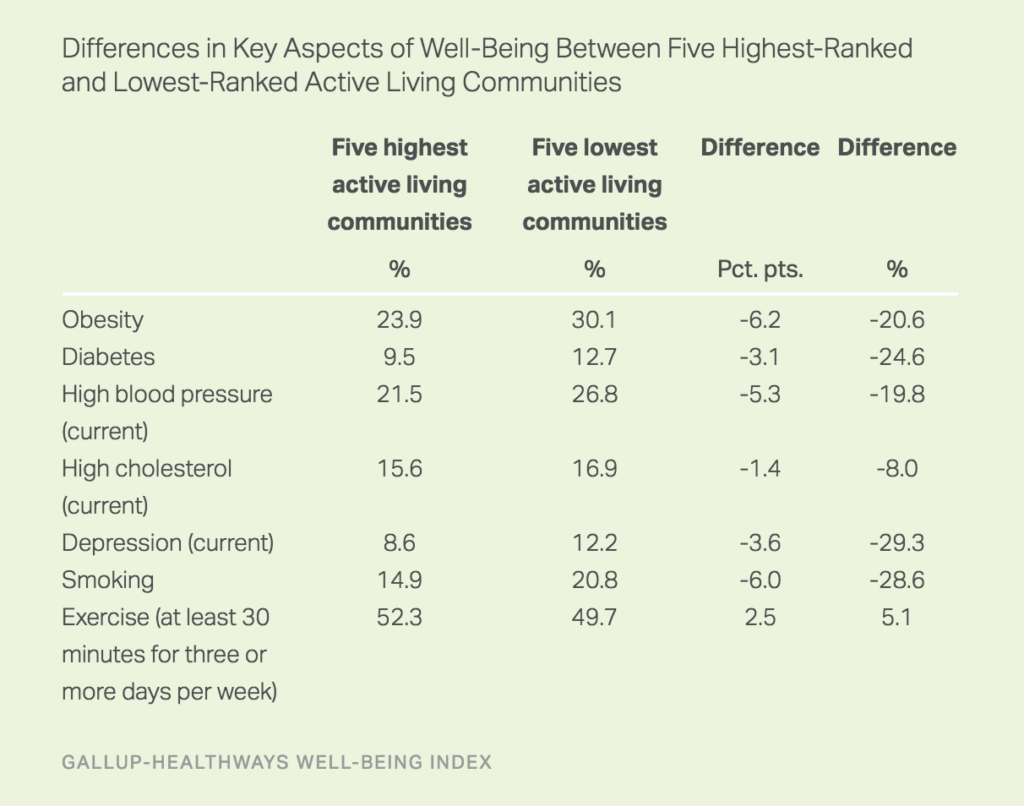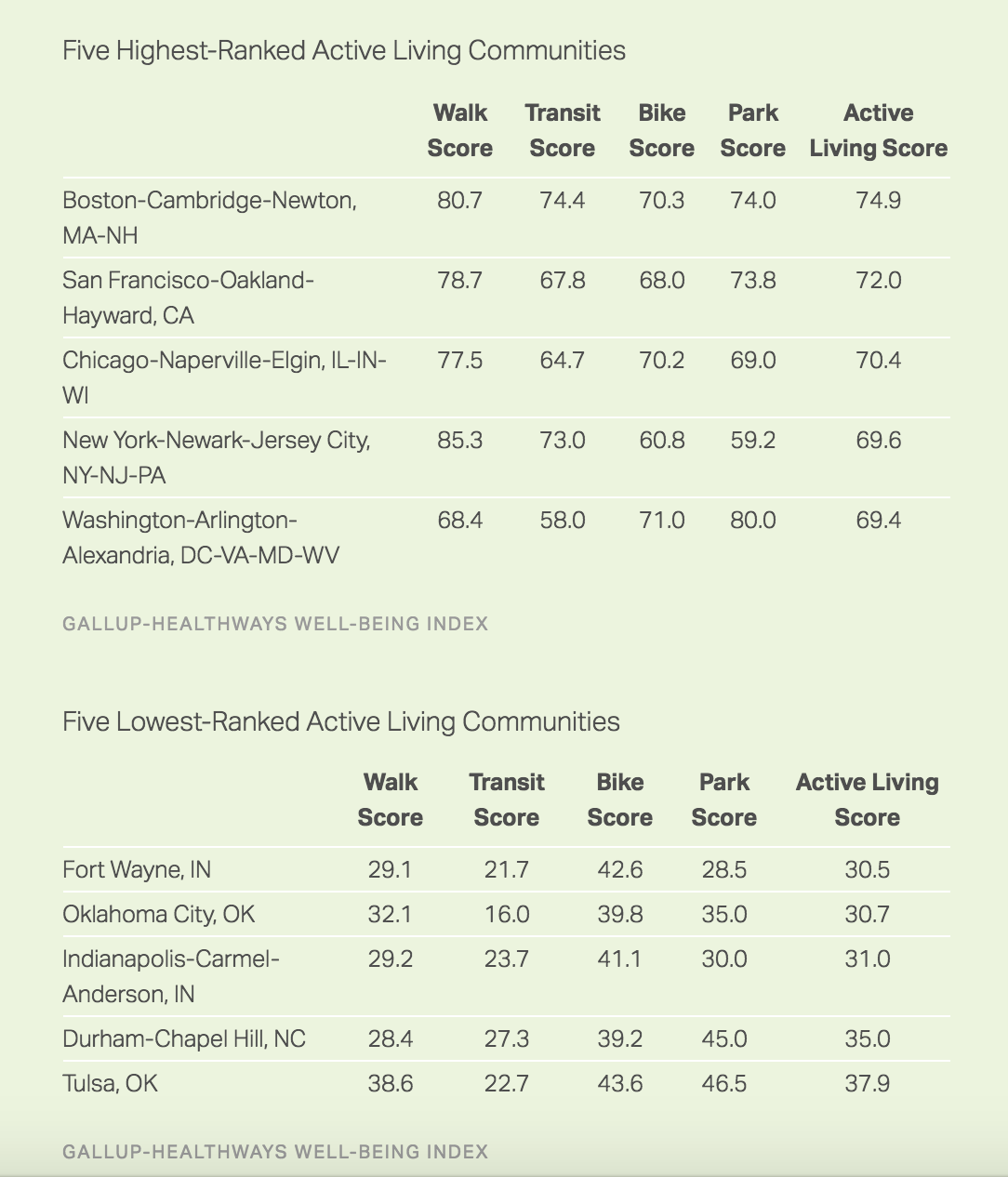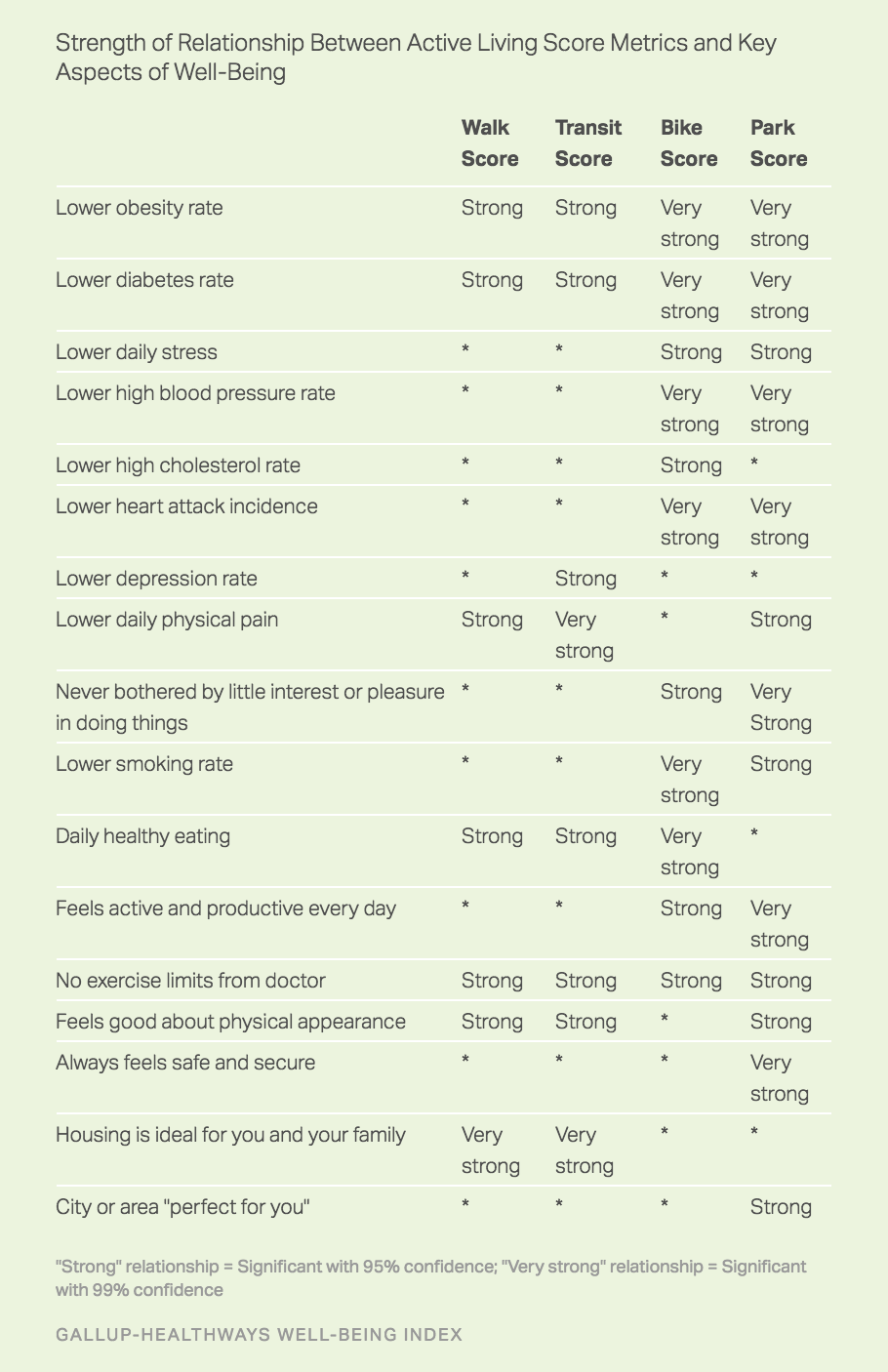Communities Built for Active Living Have Healthier Residents
Communities with the greatest investment in supporting active lifestyles yield residents who do significantly better in key aspects of well-being.
Across 48 communities studied nationwide, residents in the five highest-ranked active living communities have, on average, significantly lower obesity, diabetes, high blood pressure, high cholesterol and rates of depression than do residents of communities with comparatively little active living infrastructure. They also report better exercise habits and lower levels of smoking.
These findings are based in part on 149,938 interviews conducted as part of the Gallup-Sharecare Well-Being Index from Jan. 2, 2014, through Dec. 30, 2015.
For this report, Gallup and Sharecare created an Active Living Score for 48 medium to large Metropolitan Statistical Areas (MSAs) across the U.S. by analyzing metropolitan infrastructure data — including walkability, bike-ability, transit infrastructure and park infrastructure — based on each community’s Walkscore® and ParkScore®. Scores for all four active living metrics were required for each MSA to be included in this analysis.
Boston, San Francisco Lead U.S. in Active Living
Among the 48 communities examined nationwide, Boston and San Francisco metropolitan areas score the highest in their overall infrastructure to support active living, followed by Chicago, New York and Washington, D.C. Indiana and Oklahoma each produce two of the bottom five active living communities: Fort Wayne, Indianapolis, Oklahoma City and Tulsa. Durham-Chapel Hill, North Carolina, has the fourth-lowest active living community ranking.
The New York City and Boston metropolitan areas are the top two communities for both walkability and transit. Madison, Wisconsin, and Portland, Oregon, have the highest bike scores, while Minneapolis and Washington, D.C., have the highest park scores.
Active Living Metrics Uniquely Influence Different Aspects of Well-Being
The four active living metrics examined in this analysis collectively provide powerful insight into a community’s results in key aspects of well-being. But each component of active living influences various well-being metrics differently.
For example, while all four active living metrics have strong negative correlations with obesity and diabetes rates, Bike Score and Park Score have stronger relationships with those two conditions than do the other two metrics. Bike Score and, to a lesser extent, Park Score are also the principal forces behind a lower likelihood of high blood pressure and heart attack incidents, along with reduced smoking rates.
Transit Score and Walk Score gain greater prominence in other aspects of well-being. Transit Score is the only one of the four metrics to have a strong relationship with reduced rates of depression, while Walk Score has the strongest correlation with feeling that housing in the community is ideal. This underscores the relationship between walkability and attitudes toward the quality of available housing.
Leadership Is Key to Enhancing Active Living in Communities
Communities that invest in the right infrastructure will increase their chances of having more active citizens. Leaders play a significant role in the shape, structure and culture of the communities they serve, but involvement of the entire community — from restaurants, schools, grocery stores and employers to residents themselves — is critical to improving the well-being of all who live there.
Many cities are pursuing opportunities to improve their infrastructure to increase the chances that their residents will live active lives.
- Albert Lea, Minnesota, established more than 10 miles of bike lanes and new sidewalks and enhanced streets to support walking and biking. The city adopted policies to reduce tobacco use and started workplace programs to promote health and social interaction. Grocery stores, restaurants, schools and workplaces made changes to make healthy choices easier, and several restaurants added outdoor dining areas. These active living improvements helped Albert Lea increase its overall well-being score by 2.8 points from 2014 to 2016, significantly outpacing both the state and the nation.
- Marion, Iowa, requires consideration of pedestrian and cyclist needs in all street projects, and new developments must have sidewalks installed within five years. Guidelines integrate trees, green space and other natural features to make streets more walkable. The city’s “Complete Streets” policy has revitalized its historic Uptown district, redirecting cars from the area and creating a pedestrian-friendly atmosphere.
- Denver’s Department of Public Works coordinates a coalition to fund the Safe Routes to School (SRTS) program, constructing new trails to encourage children to walk or bike to school in safe environments. Residents of Denver’s Park Hill neighborhood trade community service for free refurbished bicycles. And Fort Collins, Colorado, has invested in at least 48 neighborhood parks and 35 miles of trail systems while boasting one of the best bicycle commuter rates in the nation.
- Eugene, Oregon, which has reduced its obesity rate since 2008, is home to well-planned and well-used cycling networks that include 28 miles of off-street paths, 78 miles of on-street bicycle lanes and four bicycle/pedestrian bridges spanning the Willamette River. Similar to Fort Collins, Eugene’s share of workers who commute by bicycle is one of the best rates in the nation among midsize cities; at 9%, it is well ahead of the national average, which is lower than 1%.
- In Chattanooga, Tennessee, the 2014-2015 obesity rate dropped by about four percentage points (from 28.5% to 24.6%) since 2008 — likely benefiting from the Grow Healthy Together Chattanooga (GHTC) partnership, which leverages Healthy Kids, Healthy Communities grant money to increase access to healthy fruits and vegetables, expand options for physical activity, and enhance infrastructure for safe movement of pedestrians and bicyclists.
Dan Buettner, National Geographic Fellow and founder of the Blue Zones Project, notes, “There are tangible policies that communities can adopt to actively cultivate and improve residents’ well-being. Policies that nudge people into healthy activities — where it is easy to walk to the store, bike to a friend’s house, get access to fresh produce and be surrounded by healthy-minded, supportive friends — are ones that make the healthy choice the easy choice. Sustained transformation depends on building an environment and establishing social policies that support and reinforce these programs.”
With this in mind, active living communities can lead the nation in how we think about, discuss and make lasting changes to enhance well-being.


